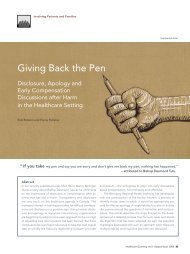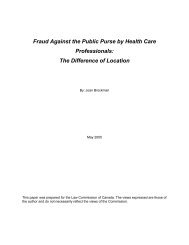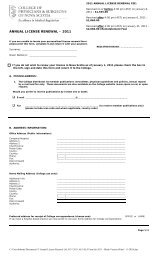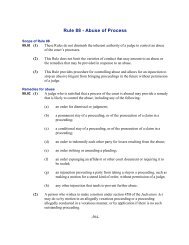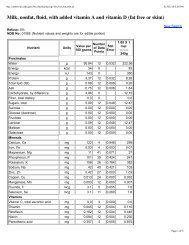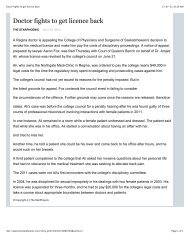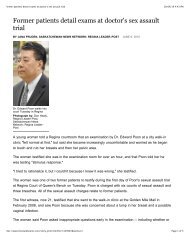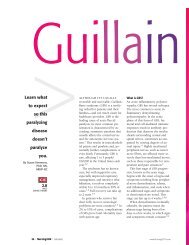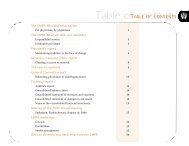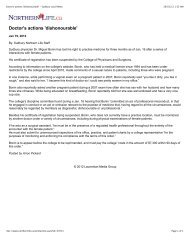Experiments That Changed Nutritional Thinking - TUUM EST
Experiments That Changed Nutritional Thinking - TUUM EST
Experiments That Changed Nutritional Thinking - TUUM EST
Create successful ePaper yourself
Turn your PDF publications into a flip-book with our unique Google optimized e-Paper software.
1024S<br />
SUPPLEMENT<br />
TABLE 2<br />
Grijns was also looking for a food material that when given<br />
in small amounts with polished rice, would prevent an outbreak<br />
Grijns’ key experiments1<br />
of polyneuritis. He tested the mung bean (which he had<br />
noticed was often included in chicken feed) and the soybean.<br />
The question asked The answer The results of his feeding experiments showed that both the<br />
skin and kernel of the mung bean prevented polyneuritis; how-<br />
1. Did a lack of minerals in a diet No, diseased chickens were ever, the soybean was less effective. Comparing the composiof<br />
white rice cause<br />
not cured.<br />
polyneuritis?<br />
tion of these two legumes, he saw that soybean was the richer<br />
2. Was the removal of fat with No, adding oil to the diet did in protein, fat and minerals but less effective as an anti-neuritic<br />
the silver skin the cause of the not prevent the disease. substance (Table 3). This supported his belief that polyneuritis<br />
disease?<br />
was not caused by a lack of these three nutrients. In later<br />
3. Was a lack of protein causing No, birds fed a supplement of experiments he found that extracts of mung bean were just as<br />
the disease? high protein soybean still labile as those from silver skin. He stated that ‘‘we therefore<br />
developed polyneuritis.<br />
4. Could the protective No, the extracts did not<br />
had the same experience with Phaseolus radiatus (mung bean)<br />
substance be extracted from prevent or cure the disease as with the seed coat of the rice . . . at every attempt to<br />
rice silver skin and mung<br />
because they decomposed isolate the active constituents, they perished . . . in different<br />
bean? during extraction. conditions they apparently became decomposed’’ (Grijns<br />
5. Was starch required to No, it appeared in chickens fed 1901).<br />
produce polyneuritis? just autoclaved meat. Eijkman had reported that the addition of some meat to<br />
1 Based on the paper by Grijns (1901).<br />
sago, tapioca and arenga starch diets did not prevent polyneuritis.<br />
However, removing starch and feeding meat alone did cure<br />
the condition. From these results, Eijkman had concluded that<br />
cal and pharmacological properties of the tannin contained in starch was a significant harmful factor in the etiology of poly-<br />
red rice’’ and to determine if the pigment found in red rice neuritis, but this explanation did not satisfy Grijns. He felt it<br />
could be considered as a curative or preventive remedy for important to determine whether polyneuritis could develop<br />
beriberi.<br />
independently of starch consumption. He therefore fed four<br />
Grijns was aware that it was not just red rice that prevented birds meat that had been extracted with water for 2 d, and all<br />
polyneuritis but all unpolished rice, and he decided to continue died with signs of polyneuritis. He then fed eight birds meat<br />
to study the whole silver skin and not just to focus on the that had been autoclaved, and six of these also developed<br />
pigment. His first feeding experiments confirmed Eijkman’s polyneuritis. Thus Grijns concluded that the development of<br />
conclusions that polyneuritis was not caused by a lack of fat, polyneuritis was not connected with starch and was even<br />
protein or mineral (Table 2). In his 1901 report, Grijns reexperiments<br />
also confirmed that the nerve degeneration was<br />
wholly independent of the presence of carbohydrate. These<br />
marked: ‘‘In judging the suitability of a food, we have not<br />
finished when we have determined the quantity of albumen not caused by a lack of protein (Table 2).<br />
. . . fat, carbohydrates and salts, even when we have applied In a discussion of polyneuritis and beriberi, Grijns put forth<br />
the corrections for digestibility. We can indeed calculate from two explanations for the symptoms that occurred: ‘‘either we<br />
this whether a balance of nitrogen will be possible with it and presume a deficiency, a partial starvation, . . . or . . . there<br />
whether the work which must be performed bother internally is a microorganism which exercises a degenerative influence<br />
and externally, can be obtained from it, but not whether perdeficiency<br />
or partial starvation, Grijns stated that very little<br />
on the nerves’’ (Grijns 1901). Concerning the possibility of a<br />
manent health is possible.’’<br />
Grijns believed that a number of substances existed, whose was known about the metabolism of the peripheral nervous<br />
actions were not explained, but which played an important system and that ‘‘if for the maintenance of the peripheral<br />
part in the prevention of disease. He illustrated this idea with nervous system, a certain substance or group of substances is<br />
two examples: ‘‘how very difficult it is, in spite of all the indispensable, which are immaterial for the metabolism of the<br />
chemical analyses of mother’s milk, to find a good substitute muscles, then it may be assumed that very little of them is<br />
for it and how frequently we find that, when we think one necessary. When therefore in certain foods the substances in-<br />
has been found, we are again disappointed’’ and ‘‘the peculiar dispensable for the nervous system are lacking or are present<br />
fact that scurvy, which usually develops from lack of fresh in insufficient quantity, in the first place any reserve supply,<br />
food, which sometimes occurs on long sea voyages, is usually which is present either in the nerve itself or in the blood or<br />
cured when the patients can again obtain fresh meat and fresh in some other organ, will be used up . . . (and) disturbances<br />
greens.’’ He concluded that still-unknown substances may be will develop.’’<br />
responsible.<br />
He explained that polyneuritis did not develop with total<br />
Grijns used two approaches for investigating these ‘‘unknown<br />
substances.’’ One was to prepare different fractions from<br />
the silver skin, and the other was by comparative assay (Grijns<br />
TABLE 3<br />
1901). He first boiled rice bran in a large quantity of water<br />
for 24 h and then strained, filtered and evaporated the liquor Composition of mung bean (P. radiatus java) and soybean<br />
to give a dried extract. He used fowls that were already consuming<br />
(S. hispida tumida java)1<br />
a polished rice diet and gave them the extract via a<br />
stomach tube. All the birds died with symptoms of polyneuritis.<br />
Mung bean<br />
Soybean<br />
Increasing the dose of the extract further had no effect; neither<br />
Albumin 21% 42%<br />
did feeding the residue from the extracted bran. Grijns con- Fat 4.1% 28%<br />
cluded that the ‘‘protective substances of the silver skin were Ash 3.6% 5.7%<br />
for the most part lost through the methods of preparation<br />
used.’’<br />
1 Modified from table of analyses published by Grijns (1901).<br />
/ 4p09$$0062 04-07-97 14:02:12 nutras LP: J Nut May Suppl<br />
Downloaded from jn.nutrition.org by on June 3, 2010



